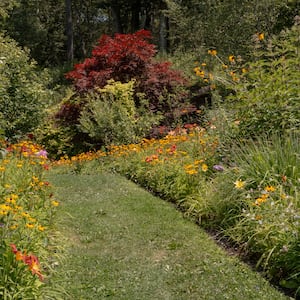Health
Cultivating Wellness: Transform Your Garden This Spring

Gardening offers more than just a pleasing aesthetic; it can also significantly enhance our physical and mental health. Numerous studies indicate that engaging in gardening activities—such as digging, weeding, and being exposed to sunlight—can reduce the risk of hypertension, heart disease, and enhance overall well-being. As the spring season approaches, horticulturalists and herbalists are sharing insights on how to create a garden that not only beautifies but also nurtures health.
According to Devon Young, a prominent herbalist and author of The Homegrown Herbal Apothecary, many plants often overlooked have medicinal properties. “People are often surprised by how many plants have medicinal and therapeutic value,” she noted. Common garden plants, including roses and hibiscus, are not just visually appealing; they also provide various health benefits. However, caution is necessary, as some plants can be toxic. Resources like the Lady Bird Johnson Wildflower Center and the Plants for a Future databases can guide gardeners in selecting safe options.
Creating a Health-Conscious Garden
For those interested in cultivating a health-promoting garden, Bridghe McCracken, founder of Helia Land Design in Massachusetts, suggests focusing on native plants. These species are generally low-maintenance and require less water and fertilizer, making them environmentally friendly. “When you’re working with native plants, you’re going to have a garden that is amazing for bees and other pollinators,” McCracken explained.
Her recommended plants include purple angelica, spiky Veronicastrum, and various types of Monarda, also known as bee balm. These plants are not only beautiful but also possess various health benefits. “Monarda punctata, in particular, is gorgeous and can be used as an antiseptic and cold remedy,” she added.
The selection process for flowers and herbs can be significantly influenced by the local ecosystem. McCracken emphasizes the importance of “listening to the land” to identify which plants thrive in specific areas, which can lead to a more vibrant and diverse garden.
Herbal Remedies and Their Preparation
Another expert in garden design, Ethan Dropkin from Larry Weaner Landscape Associates, incorporates a blend of aesthetics and functionality in his designs. He often creates “human-centric areas” near residences while allowing for more naturalistic growth further out. His gardens feature an array of native plants, including Echinacea and Rudbeckia, which have medicinal uses.
Dropkin highlights the health benefits of native mints and yarrow, noting their antibacterial properties. “You can pick the leaves and use them on cuts, or make tea from them,” he explained, underscoring their dual role in supporting both human health and local ecosystems.
Young elaborated on the various methods for preparing herbal remedies, which often depend on the type of plant. “Anything with a fairly thin leaf or delicate flower can hang dry,” she stated. For more succulent plants, she suggests using a dehydrator. Young also emphasizes the versatility of native plants, using the entire plant—roots, stems, leaves, and flowers—for maximum benefit.
Connecting with Nature and Healing
Interest in wellness gardens is growing, as individuals seek natural remedies for chronic health issues. Dara Saville, author of The Ecology of Herbal Medicine, observes a diverse range of motivations among her students at Albuquerque Herbalism, from ecological awareness to a desire to connect with Indigenous healing traditions. “Many are taking matters into their own hands,” she noted, as they seek effective alternatives to conventional healthcare.
Saville describes her gardening style as “feral,” allowing plants to grow where they feel most comfortable. She advocates for the medicinal benefits of plants like yerba mansa, known for its energizing effects on various bodily systems.
In New York City, landscape designer Mihalis Petrou has embraced a similar philosophy, transforming an abandoned lot into a lush habitat filled with native plants. His work has gained attention in the fashion industry, where he incorporates these plants into photo shoots and events. “Instead of going to the flower market, I would head to my garden in Queens and harvest fresh native plants,” he shared.
Petrou believes that the aesthetic appeal of a garden can enhance mental health, paralleling the connections between beauty and well-being. “Art is therapy and landscaping is art,” Young echoed, reinforcing the idea that a well-designed wellness garden can serve as both a visual delight and a source of healing.
As gardeners prepare for the spring season, the potential for cultivating a health-promoting garden is vast. By selecting native plants with both aesthetic and medicinal qualities, individuals can nurture their well-being while fostering a vibrant ecosystem.
-

 World4 months ago
World4 months agoTest Your Knowledge: Take the Herald’s Afternoon Quiz Today
-

 Sports4 months ago
Sports4 months agoPM Faces Backlash from Fans During Netball Trophy Ceremony
-

 Lifestyle4 months ago
Lifestyle4 months agoDunedin Designers Win Top Award at Hokonui Fashion Event
-

 Entertainment5 months ago
Entertainment5 months agoExperience the Excitement of ‘Chief of War’ in Oʻahu
-

 Sports4 months ago
Sports4 months agoLiam Lawson Launches New Era for Racing Bulls with Strong Start
-

 World5 months ago
World5 months agoCoalition Forms to Preserve Māori Wards in Hawke’s Bay
-

 Health4 months ago
Health4 months agoWalking Faster Offers Major Health Benefits for Older Adults
-

 Lifestyle4 months ago
Lifestyle4 months agoDisney Fan Reveals Dress Code Tips for Park Visitors
-

 Politics4 months ago
Politics4 months agoScots Rally with Humor and Music to Protest Trump’s Visit
-

 Top Stories5 months ago
Top Stories5 months agoUK and India Finalize Trade Deal to Boost Economic Ties
-

 Health2 months ago
Health2 months agoRadio Host Jay-Jay Feeney’s Partner Secures Visa to Stay in NZ
-

 World5 months ago
World5 months agoHuntly Begins Water Pipe Flushing to Resolve Brown Water Issue









